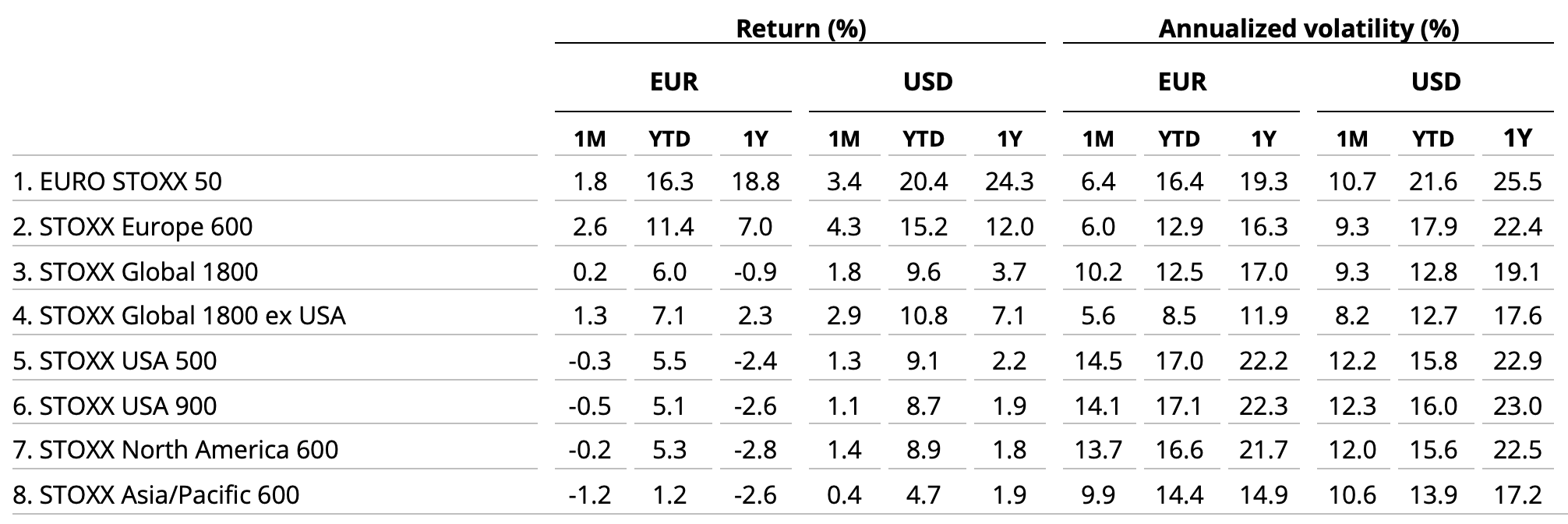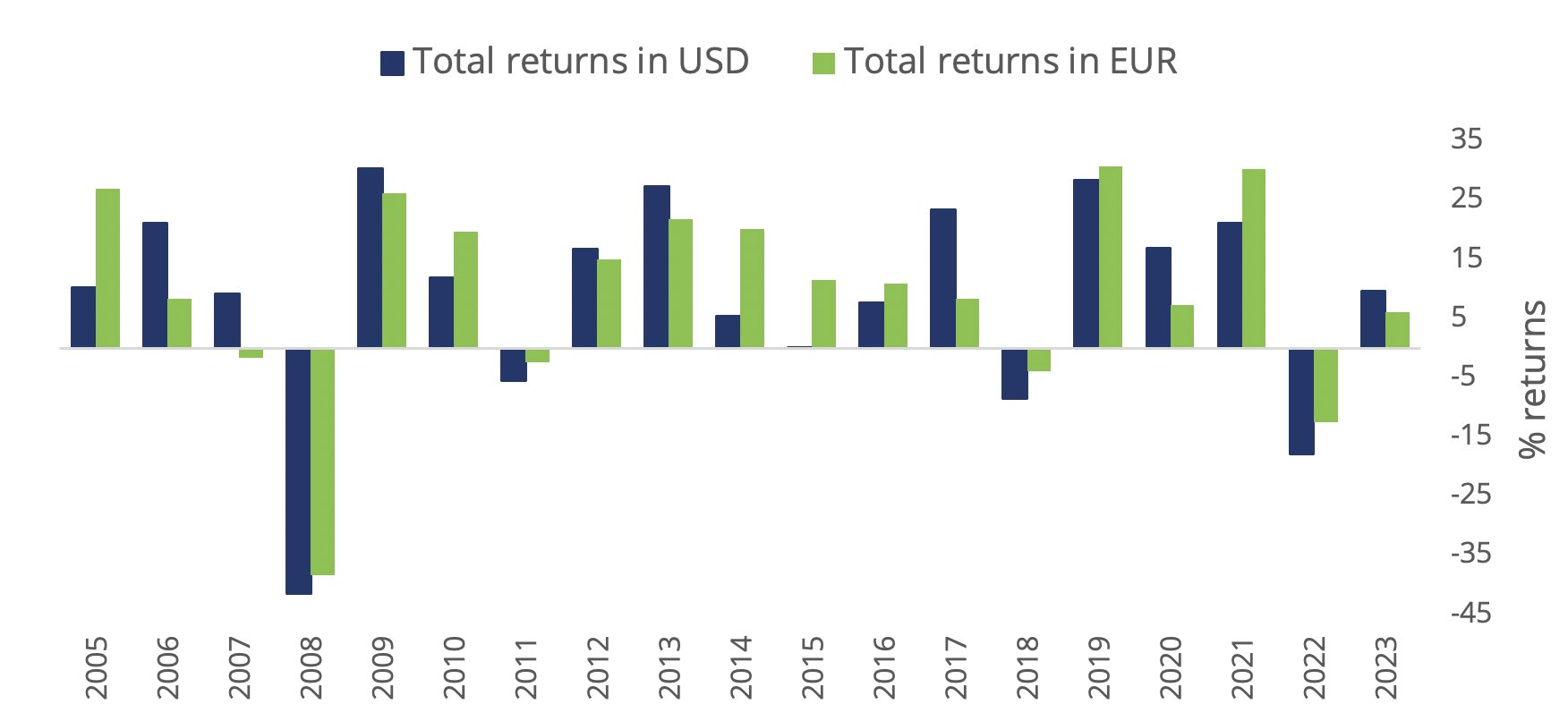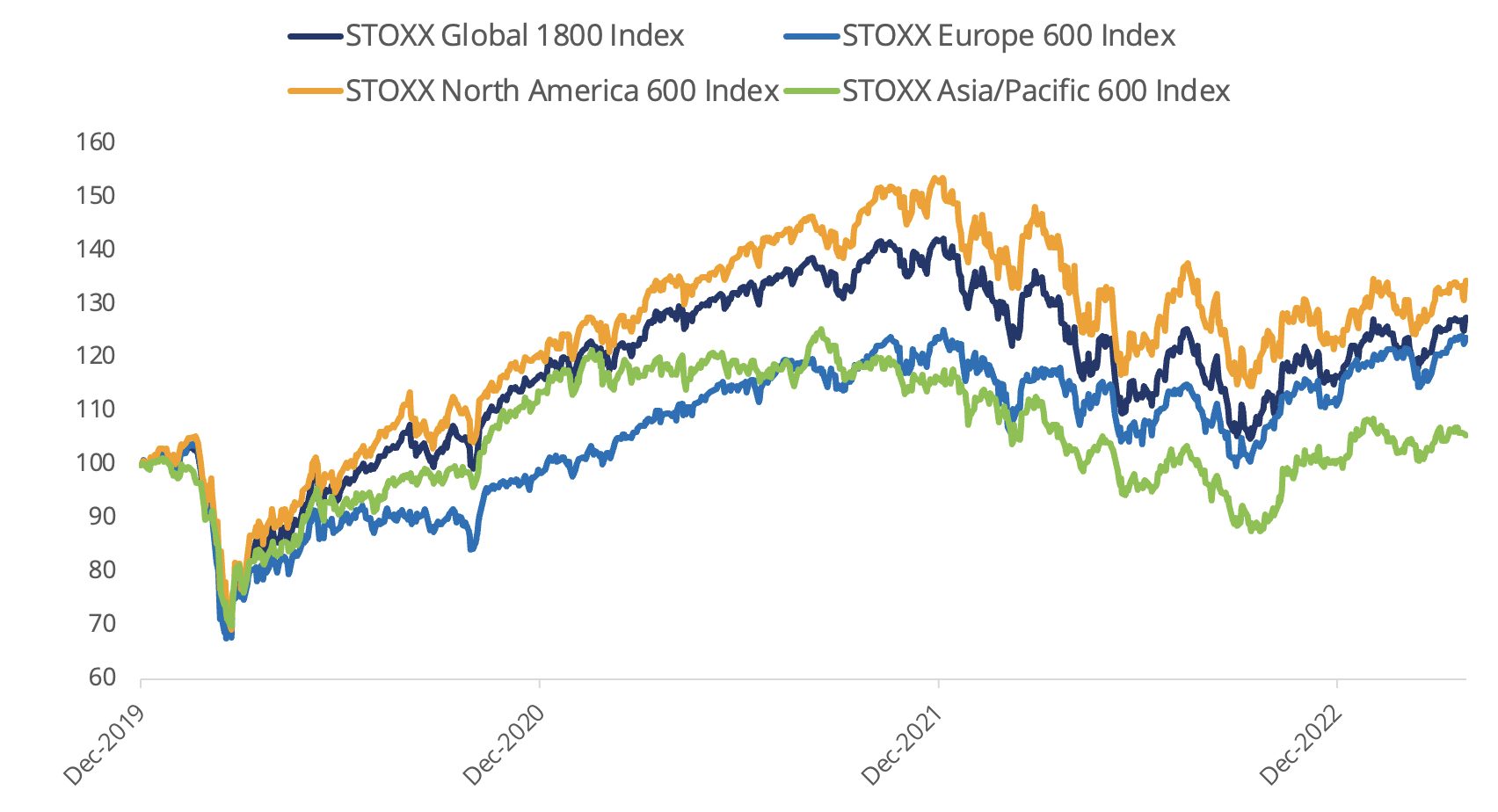Stocks rose in April following better-than-expected economic and earnings reports, and amid signs that inflation in key regions continues to cool.
The STOXX® Global 1800 index added 1.8% last month when measured in dollars and including dividends1. The benchmark slid 17.9% in 2022, its worst year since 2008, as central banks pressed ahead with higher rates to fight runaway inflation. The index added 0.2% in euros last month after the greenback fell 1.6% against the common currency. The STOXX® World AC index climbed 1.5% in dollars.
The Eurozone’s EURO STOXX 50® gained 1.8% in euros in the month, while the pan-European STOXX® Europe 600 increased 2.6%.2 The STOXX® North America 600 climbed 1.4% in dollars, while the STOXX®USA 500 rose 1.3%. The STOXX® Asia/Pacific 600 gained 0.4% in dollars.
Figure 1: Benchmark indices’ April risk and return

Figure 2: STOXX Equity World indices’ April risk and return

Germany’s DAX® rose 1.9% in the month. MDAX®, which gauges the performance of German mid-caps, gained 0.7%.
| For a complete review of all indices’ performance last month, visit our April index newsletter. |
Economic and business reports show better-than-expected picture
Business activity in the US and the Eurozone expanded faster than expected in April, according to preliminary figures released in the month. Consumer prices in the two regions decreased in March to the lowest in several months, reports showed in April. Meanwhile, US companies that reported their first-quarter earnings by Apr. 27 have beaten estimates by 6.9%, the highest rate in two years, according to RBC Wealth Management.3
Figure 3: Annual % returns for STOXX Global 1800 index

Figure 4: Returns since Jan. 1, 2020

Volatility drops
The EURO STOXX 50® Volatility (VSTOXX®), which tracks EURO STOXX 50 options prices, fell to 17.4 at the end of last month from 19.4 in March. A higher VSTOXX reading suggests investors are paying up for puts that offer insurance against stock price drops. The VDAX-New®, which measures volatility in German equities, also slipped to 17.4, from 18.9 in March.
Insurance Supersector leads gains
All but three of 20 Supersectors in the STOXX Global 1800 had gains in April, led by a 5.1% advance for the STOXX® Global 1800 Insurance index. At the other end of the table, the STOXX® Global 1800 Automobiles & Parts index fell 9.5%.
Twenty of 25 developed markets tracked by STOXX advanced in April when measured in dollars. The STOXX® Developed World index rose 1.6% in dollars.
Fourteen of 20 national developing markets tracked by STOXX climbed in the month on a dollar basis. The STOXX® Emerging Markets index fell 1% in the US currency.
Factor investing
On a global basis, Low Risk was the leading style factor for a second month, according to the STOXX Factor indices.
Figure 5: STOXX Factor (Global) indices’ April risk and return characteristics

Climate benchmarks
Among climate benchmarks, the STOXX® Global 1800 Paris-Aligned Benchmark (PAB) (1.5%)4 and the STOXX® Global 1800 Climate Transition Benchmark (CTB) (1.6%) underperformed their benchmark in the month. The PAB and CTB indices follow the requirements outlined by the European Commission’s climate benchmarks regulation.
The STOXX® Willis Towers Watson World Climate Transition Index added 1.6% in the month. The STOXX Willis Towers Watson Climate Transition Indices (CTIs) employ a unique Climate Transition Value at Risk (CTVaR) methodology that quantifies the anticipated impact of an economic transition on equity valuations. The CTIs look beyond carbon emissions and make a forward-looking, bottom-up evaluation of asset repricing risks in a decarbonization pathway.
Among the STOXX Low Carbon indices, the EURO STOXX 50® Low Carbon (+1.7%) performed broadly in line with the EURO STOXX 50 in April. Elsewhere, the STOXX® Global Climate Change Leaders (+3%), which selects corporate leaders that are publicly committed to reducing their carbon footprint, beat the STOXX Global 1800 index by 114 basis points last month.
Sustainability indices
The STOXX® Global 1800 ESG-X index gained 1.7% in the month. The STOXX® ESG-X indices are versions of traditional, market-capitalization-weighted benchmarks that observe standard responsible exclusions.
Within indices that combine exclusions and ESG best-in-class integration, the EURO STOXX 50® ESG index gained 1.4% in April. Germany’s DAX® 50 ESG index (+1.4%), which excludes companies involved in controversial activities and integrates ESG scoring into stock selection, underperformed the benchmark DAX.
Among other STOXX sustainability families, the STOXX® Global 1800 ESG Broad Market index rose 1.7% in the month. The STOXX ESG Broad Market indices apply a set of compliance, product involvement and ESG performance exclusionary screens on a starting benchmark universe until only the 80% top ESG-rated constituents remain.
The STOXX® Global 1800 ESG Target climbed 2.1%, the EURO STOXX® ESG Target rose 1.5% and the DAX® ESG Target added 2.1%. The STOXX and DAX ESG Target indices seek to significantly improve the benchmark portfolio’s ESG profile while mirroring its returns as closely as possible. Through a series of constraints, the indices implement an optimization process to maximize the overall ESG score of the portfolio while limiting the tracking error to the benchmark.
The STOXX® Global 1800 SRI advanced 1.7%. The STOXX SRI indices apply a rigorous set of carbon emission intensity, compliance and involvement screens, and track the best ESG performers in each industry group within a selection of STOXX benchmarks.
Finally, the DAX® ESG Screened added 1.6% in the month. The index reflects the composition of the DAX benchmark minus companies that fail to pass norms-based and controversial weapons screenings, meet minimum ESG ratings or are involved in certain business activities considered undesirable from a responsible investing perspective.
Luxury goods lead gains among thematic indices
Among 26 STOXX® Thematic indices, 19 underperformed the benchmark STOXX Global 1800 last month. The STOXX® Global Smart Cities index showed the steepest loss in April (-9.6%). The STOXX® Europe Luxury 10 index led gains with a 4.6% advance.
Dividend strategies
Dividend strategies had diverse performances last month. The STOXX® Global Maximum Dividend 40 (+4.5%) selects only the highest-dividend-yielding stocks. The STOXX® Global Select Dividend 100 (+1%) tracks companies with sizeable dividends but also applies a quality filter such as a history of stable payments.
Minimum variance
Minimum variance strategies had good performances last month as investors sought low-risk shares. The STOXX® Global 1800 Minimum Variance rose 2.9% and the STOXX® Global 1800 Minimum Variance Unconstrained climbed 3.6%.
The STOXX Minimum Variance Indices come in two versions. A constrained version has similar exposure to its market-capitalization-weighted benchmark but with lower risk. The unconstrained version, on the other hand, has more freedom to fulfill its minimum variance mandate within the same universe of stocks.
1 All results are total returns before taxes unless specified.
2 Throughout the article, all European indices are quoted in euros, while global, North America, US, Japan and Asia/Pacific indices are in dollars.
3 RBC, “So far, so good – sort of – for U.S. earnings season.”
4 Figures in parentheses show last month’s gross returns.
